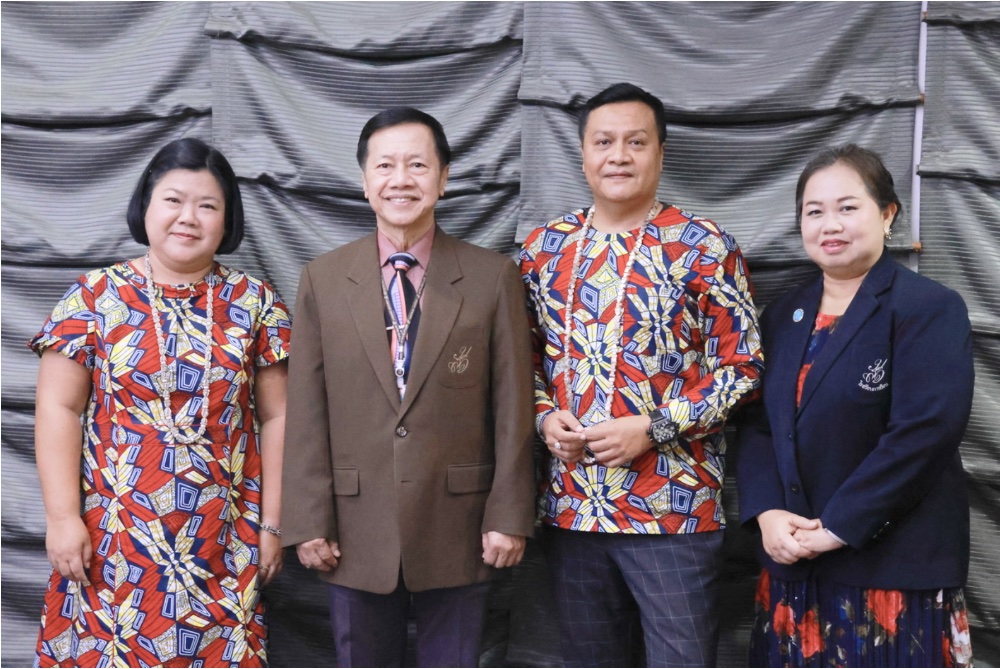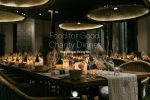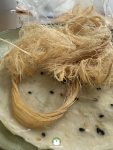จากซ้าย ผศ.ดร.ดวงกมล อัศวมาศ ผศ.ดร.พิทักษ์ จันทร์เจริญ ผศ.ดร.สาระ มีผลกิจ ดร.จันทร์จนา ศิริพันธ์วัฒนา
กรุงเทพฯ – 30 สิงหาคม พ.ศ. 2567
อาหารที่เรากินมักจะอร่อยขึ้นเสมอ เมื่อเราได้รู้ที่มาที่ไปของมัน และโดยเฉพาะเมื่อได้เรียนรู้จากผู้ที่ทำการศึกษาเรื่องอาหารไทยอย่างจริงจัง
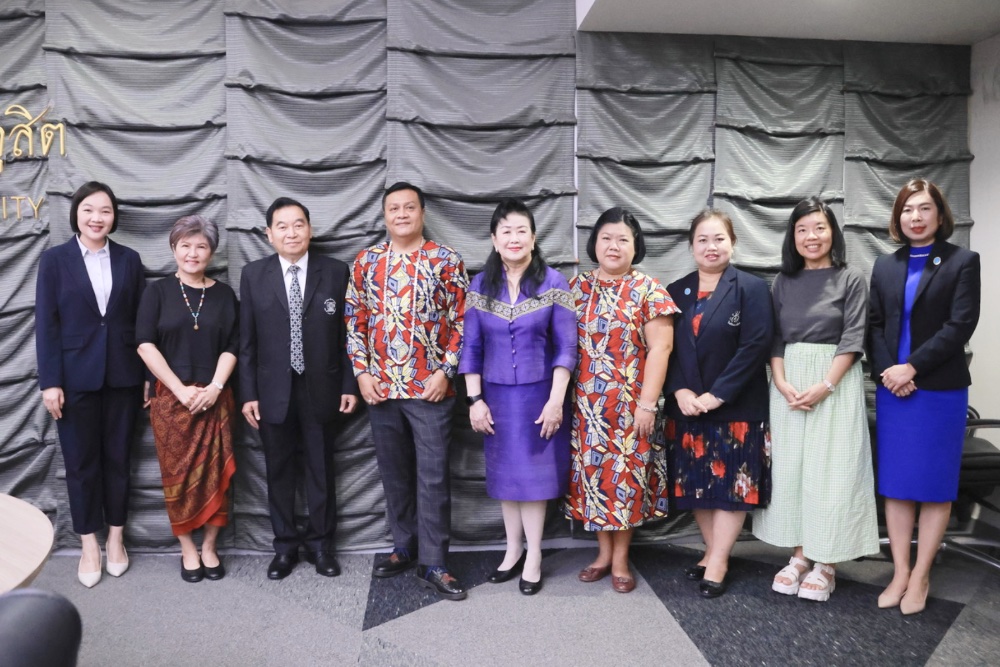 จากมหาวิทยาลัยสวนดุสิต จากซ้าย นางสาวพรพรรณ บัวทอง (ซ้ายสุด) รศ.ดร.สุขุม เฉลยทรัพย์ (ที่สามจากซ้าย) ผศ.ดร.สาระ มีผลกิจ (ที่สี่จากซ้าย)
จากมหาวิทยาลัยสวนดุสิต จากซ้าย นางสาวพรพรรณ บัวทอง (ซ้ายสุด) รศ.ดร.สุขุม เฉลยทรัพย์ (ที่สามจากซ้าย) ผศ.ดร.สาระ มีผลกิจ (ที่สี่จากซ้าย)
ดร.วรานี เวสสุนทรเทพ (ที่ห้าจากซ้าย) ผศ.ดร.ดวงกมล อัศวมาศ (ที่หกจากซ้าย) ดร.จันทร์จนา ศิริพันธ์วัฒนา (ที่เจ็ดจากซ้าย) ผศ.ทิพสุดา คิดเลิศ (ขวามือสุด)
มหาวิทยาลัยสวนดุสิตมีกิจกรรมที่เรียกว่า Wisdom Academy ที่จัดขึ้นเพื่อสร้างการเรียนรู้อย่างต่อเนื่องให้แก่ผู้ที่มีอายุ 60 ปีขึ้นไป และเมื่อไม่นานมานี้ มีการจัดเสวนาหัวข้อ “พินิจสำรับสวนดุสิต” เพื่อเล่าที่มาที่ไปของอาหารขึ้นชื่อ 10 อย่างของมหาวิทยาลัย โดยมีผู้บรรยายได้แก่ ดร.จันทร์จนา ศิริพันธ์วัฒนา ผู้จัดการสวนดุสิตโฮมเบเกอรี ผศ.ดร.สาระ มีผลกิจ และ ผศ.ดร.ดวงกมล อัศวมาศ มหาวิทยาลัยสวนดุสิต
“ความเป็นผู้ดีมีเวลามาก เวลารับประทานขนมจีน จะต้องยีเส้นขนมจีนให้ฟูเสียก่อน แล้วจึงค่อยคลุกเคล้าด้วยน้ำยาให้เข้ากัน คำนี้จะกินกับผักนี้คือหนึ่งคำ ต่อมาเวลามันเร่งรีบ จึงกลายเป็นจับแล้วราดกินรวมกันเลย” ผศ.ดร.สาระ เล่าให้ฟังในการบรรยาย เป็นหนึ่งในความรู้ใหม่ที่เชื่อว่าแม้แต่คนที่กินขนมจีนทุกวันในปัจจุบันก็ยังไม่รู้
For foodies with a curious mind, nothing beats learning the backstory of the food on the plate, especially when hearing it from those who study it seriously.
Suan Dusit University has a project called Wisdom Academy, designed to provide continuous learning for individuals aged 60 and above. Recently, a seminar titled “A Review of Suan Dusit Dishes” was held to discuss the origins of 10 signature dishes of the university. The speakers included Dr. Chanchana Siripanvattana, Manager of Suan Dusit Home Bakery, Assistant Professor Dr. Sara Meepolkij, and Assistant Professor Dr. Duangkamol Assawamart from Suan Dusit University.
“Back in the day, refined people had plenty of time. When eating khanom chin, they would first fluff the rice noodles just before mixing them with the curry. One bite is eaten with one vegetable, another bite with another vegetable. As life became more rushed, it evolved into grabbing the noodles and pouring the curry over them, and eating them mixing everything together like we see today,” said Dr. Sara Meepolkij.
And this is a new piece of knowledge that even those who eat khanom chin everyday might not realise.
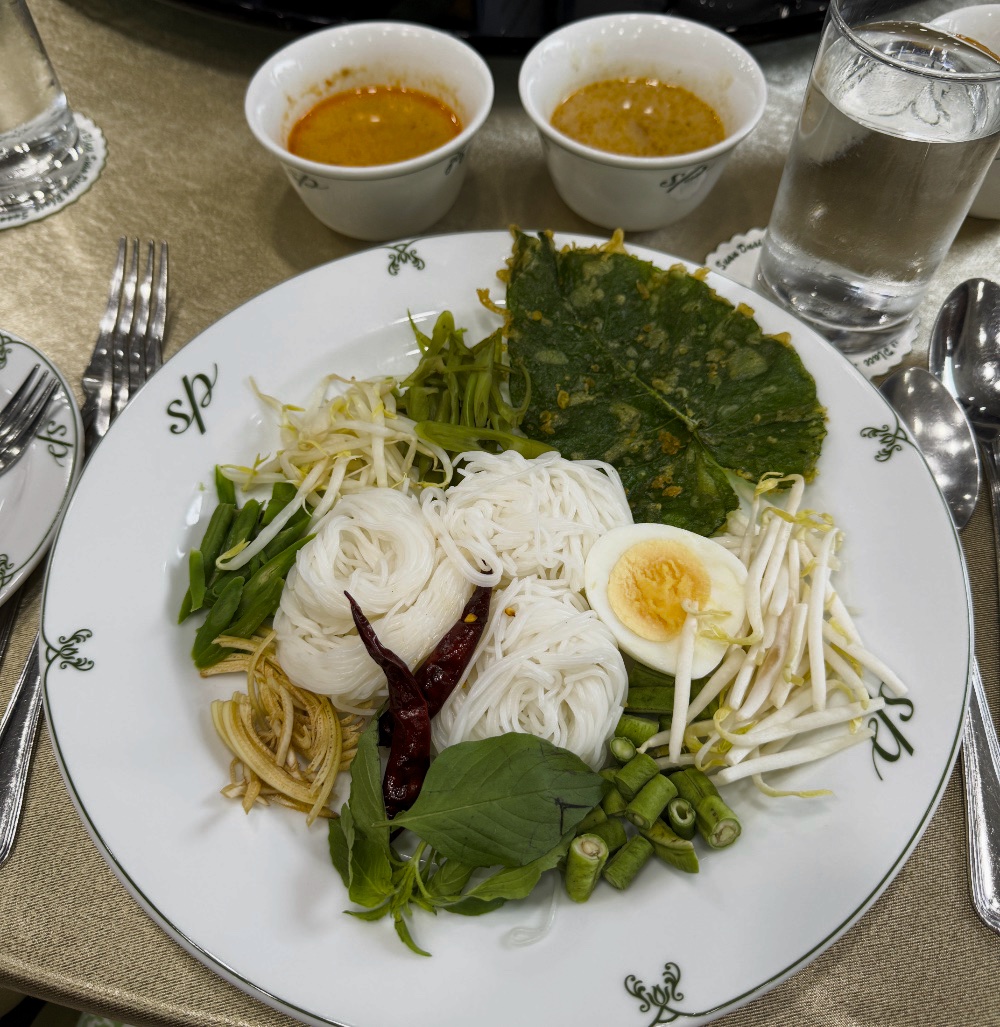 ขนมจีนน้ำยา และขนมจีนน้ำพริก ที่รับประทานกับ “เหมือด” หรือผักต่าง ๆ ทั้งผักสดและทอดในสำรับ
ขนมจีนน้ำยา และขนมจีนน้ำพริก ที่รับประทานกับ “เหมือด” หรือผักต่าง ๆ ทั้งผักสดและทอดในสำรับ
มหาวิทยาลัยสวนดุสิต มีสถานการศึกษาที่เก่าแก่และมีชื่อเสียงมากเป็นอันดับต้น ๆ ของประเทศไทยในเรื่องของอาหารการกิน จากต้นกำเนิดที่เป็นโรงเรียนการเรือนแห่งแรกของประเทศไทย ในชื่อว่า “โรงเรียนการเรือนพระนคร” ที่นี่คือแหล่งสะสมความรู้ เรื่องราวมากมายที่ประกอบเป็นวัฒนธรรมการกิน รากเหง้าที่สำคัญของประเทศไทย ที่กลายมาเป็นอาหารไทย ที่มีชื่อเสียงระดับโลก เป็นพื้นฐานในการต่อยอดให้แก่คนรุ่นใหม่ ที่สนใจเรื่องอาหาร และต้องการนำข้อมูลและทักษะเหล่านี้ไปใช้งานต่อไป
ก่อนอื่น อาจารย์ผู้บรรยายต้องการให้เราทำความเข้าใจก่อนว่า ในระยะเวลากว่า 90 ปี ที่มหาวิทยาลัยสวนดุสิตตั้งอยู่ แม่ว่าปัจจุบันจะอยู่ในพื้นที่ของวังเก่า แต่ตำรับตำราอาหารไทย 10 จานที่จะกล่าวถึงนี้ กลับไม่ใช่สูตรชาววังอย่างที่ทุกคนคาดหวัง แต่กลับเป็นสูตรที่ได้รับการปรับปรุงด้วยฝีมือของบรรดาผู้ทำอาหารเลี้ยงนักเรียน นักศึกษา ผสมผสานกับวิธีครูพักลักจำ แม้ว่าอาหารบางอย่างจะมีพื้นฐานมาจากสูตรชาววัง แต่พอมาถึงมือของแม่ครัวชาวสวนดุสิตแล้ว ก็จะต้องมีการปรับปรุงเปลี่ยนแปลงให้มีรสชาติที่เป็นเอกลักษณ์ของที่นี่ทั้งหมด
“ตัวอย่างเช่น เมี่ยงคำ ที่มีจุดเด่นที่น้ำจิ้ม” ดร.จันทร์จนา กล่าว “แม้ว่าเราจะมีสูตรน้ำเมี่ยงคำที่เป็นสูตรพื้นฐานที่หาได้ทั่วไป แต่น้ำเมี่ยงคำของเราก็มีวิธีทำในแบบของเรา จนผู้ที่ชอบรับประทานของอร่อยหลายท่าน พอมาได้รับประทานเมี่ยงคำของเรา ก็จะบอกแบบเดียวกันว่า อร่อยมาก และไม่เหมือนที่ไหน”
Suan Dusit University is one of the most prestigious educational institutions in Thailand, and particularly known for its culinary expertise. Originating as Thailand’s first home economics school, under the name “Rong Rien Karn Ruen Phranakhon,” it has accumulated extensive knowledge that forms an integral part of Thai food culture. These traditions, which have shaped Thai cuisine’s global reputation, serve as a foundation for new generations interested in food to continue developing their skills further.
First, the lecturers wanted us to understand that in the 90-plus years that Suan Dusit University has existed, despite being located in the grounds of an old palace, the 10 Thai dishes they are about to discuss are not royal recipes as one might expect. Instead, these dishes have been refined by the university’s cooks, who served meals to students and staff, combining their knowledge with hands-on learning. Although some dishes may have royal origins, once in the hands of Suan Dusit’s chefs, they were adapted to create the university’s signature flavours.
“For example, miang kham, where the highlight is the dipping sauce,” said Dr. Chanchana. “Ours is unique. While we follow a basic recipe, the method of making our sauce is different. Many food lovers, after trying our miang kham, say the same thing: it’s delicious and unlike anywhere else.”
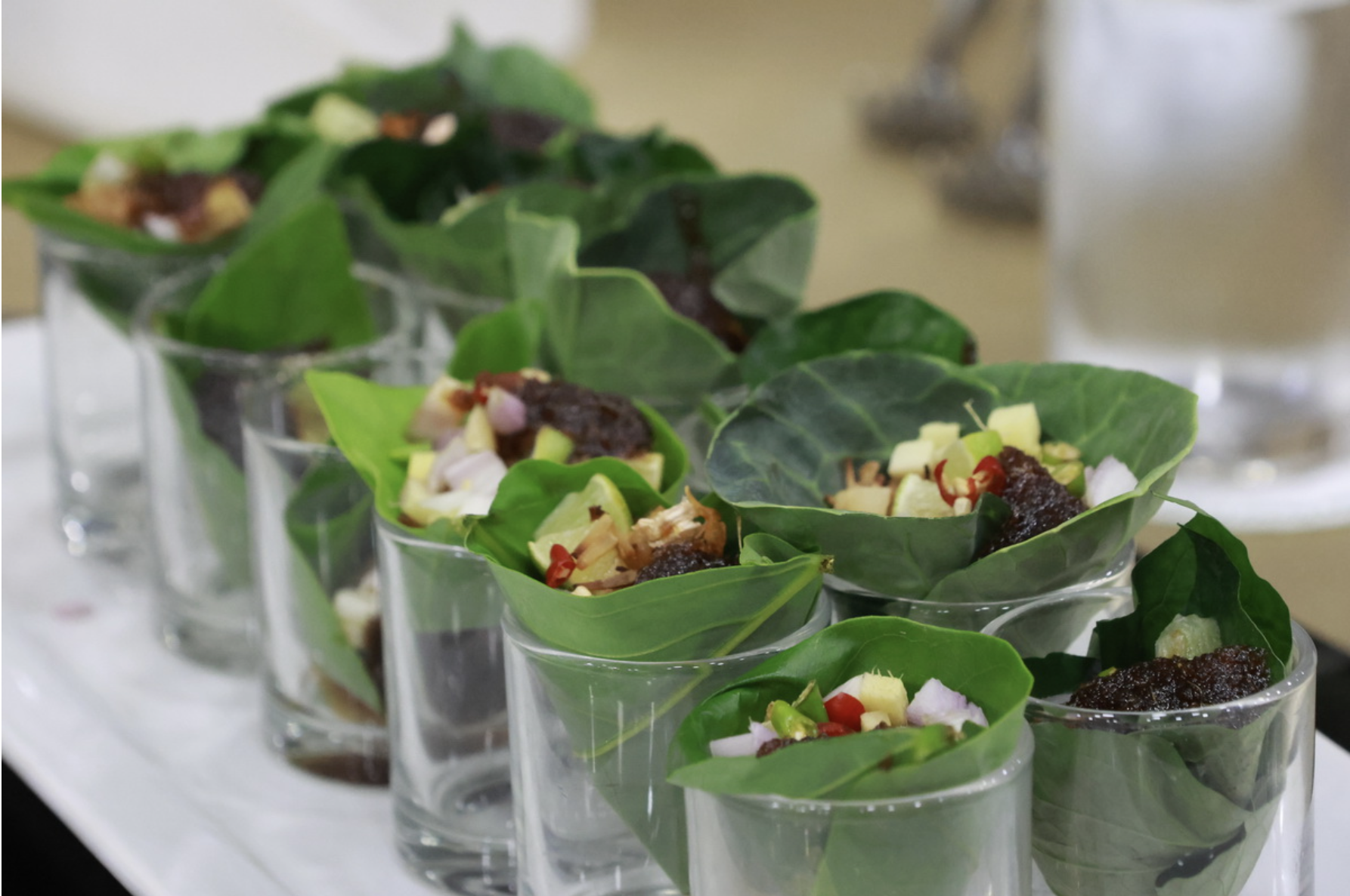 เมี่ยงคำตำรับสวนดุสิต ที่มีจุดเด่นที่น้ำจิ้ม รสชาติกลมกล่อม อร่อยมาก เมี่ยงคำมักถูกหยิบยกให้เป็นตัวอย่างของอาหารไทย ที่ครบรส และเต็มไปด้วยโภชนาการทางอาหารอยู่เสมอ
เมี่ยงคำตำรับสวนดุสิต ที่มีจุดเด่นที่น้ำจิ้ม รสชาติกลมกล่อม อร่อยมาก เมี่ยงคำมักถูกหยิบยกให้เป็นตัวอย่างของอาหารไทย ที่ครบรส และเต็มไปด้วยโภชนาการทางอาหารอยู่เสมอ
การสัมนาครั้งนี้ เป็นเรื่องตื่นเต้นและสนุกมากสำหรับคนที่รักอาหารและเรื่องราวทั้งเบื้องหลังเลื้องหน้าของอาหาร เพราะการพูดเล่าเรื่องอาหารโดยนักประวัติศาสตร์อย่าง ดร.สาระ และนักโบราณคดีอย่าง ดร.ดวงกมล และนักวิทยาศาสตร์การอาหารอย่าง ดร.จันทร์จนา คือการได้มองอาหารไทย ที่เรารับประทานกันอยู่ทุกเมื่อเชื่อวัน ได้อย่างครบมิติ อาหารไทยที่เรากินกันจนถึงทุกวันนี้นี้ ล้วนเป็นของที่บรรพบุรุษเราได้คิดได้ทำไว้ให้ทั้งสิ้น และเมื่อมาได้พิจารณาถึงรายละเอียดในขณะรับประทาน ในขณะที่ได้รับรสชาติที่ครบรส แสนจะอร่อยของอาหารแต่ละจาน ก็ยิ่งทำให้เห็นคุณค่าของอาหารไทยที่อยู่ใกล้ตัวเรามากขึ้นอีกหลายร้อยเท่า
“ไม่ใช่เรื่องเกินจริงเลยที่อาหารไทยจะได้รับการยกย่องว่าเป็นยาที่อร่อยที่สุดในโลก” ดร.ดวงกมลกล่าว “ของที่เรากินกันเป็นประจำอย่างเมี่ยงคำ ในหนึ่งคำมีทั้งความอร่อยจากของที่คนคิดนำมาผสมกัน และยังได้ประโยชน์ทางโภชนาการอีกมากมาย และนี่คือความชาญฉลาดของคนไทยในเรื่องอาหาร”
พูดถึงอาหารไทยในปัจจุบัน ที่ได้รับการยกย่องในระดับโลก ยิ่งทำให้เห็นว่า หากเราได้ศึกษาสิ่งที่คนสมัยก่อนได้ทำไว้ให้อย่างละเอียด เราจะยิ่งภูมิใจ เข้าใจ และสามารถนำเสนออาหารและวัฒนธรรมการกินของบ้านเราได้ลึกซึ้งยิ่งขึ้น โดยเฉพาะเมื่อได้เห็นหลักฐานโบราณ ตั้งแต่ “กาพย์เห่ชมเครื่องคาวหวาน” ของในหลวงรัชกาลที่ 2 ที่ได้ทรงประพันธ์ไว้เมื่อกว่า 250 ปีก่อน ที่กลายมาเป็นสารตั้งต้น ในอีกกว่า 100 ปีถัดมา เมื่อท่านผู้หญิงเปลี่ยน ภาสกรวงศ์ ใช้เป็นเอกสารอ้างอิงในตำรา “แม่ครัวหัวป่าก์” ของท่าน และในบรรดาหลักฐานความเอิกเริกของอาหารไทย ก็ยังมี “กาพ์เห่ชมเครื่องว่าง” โดยพระบาทสมเด็จพระมงกุฏเกล้าเจ้าอยู่หัว รัชกาลที่ ๖ อีกด้วย
ซึ่งเมื่อดูย้อนกลับไป อาหารไทย ที่ทำให้ประเทศเรามีชื่อเสียงทุกวันนี้ ต่างมีอายุอย่างน้อย 300-400 ปี เพราะเป็นการเก็บสะสมองค์ความรู้ สูตรอาหารต่าง ๆ มาตั้งแต่สมัยอยุธยา
“การศึกษาที่ดีจะต้องเข้าใจถึงองค์รวมของสิ่งต่าง ๆ ไม่ใช่จับแยกของแต่ละอย่างออกจากกัน” ดร. สาระกล่าว “การมองอาหารไทยในมุมของนักประวัติศาสตร์ เป็นการมองแบบองค์รวม ทำให้เห็นภาพวิถีชีวิตรวมทั้งบริบทที่รายล้อมวัฒนธรรมการกินของเรา โดยหากผู้ที่เห็นภาพนี้ ก็จะสามารถเล่าต่อ ประชาสัมพันธ์ประเทศเรา วัฒนธรรมของเราได้อย่างเข้าใจลึกซึ้งยิ่งขึ้น ตัวอย่างที่เห็นก็คือ บทประพันธ์ต่าง ๆ ร้อยแก้วที่เราคิดว่าเชย เรียนไปก็ไม่มีประโยชน์ กลับกลายเป็นวิธีที่สามารถบรรยายอาหารไทยได้อย่างแสนลึกซึ้ง สวยงาม และเก็ยรายละเอียดได้ครบ ลองคิดดูว่าหากเราบรรยายเมี่ยงโดยใช้ภาษาธรรมดา จะเป็นอย่างไร”
“เมี่ยงคำน้ำลายสอ เมี่ยงสมอเมี่ยงปลาทู
ข้าวคลุกคลุกไก่หมู น้ำพริกกลั้วทั่วโอชา”
จาก “กาพ์เห่ชมเครื่องว่าง” โดยพระบาทสมเด็จพระมงกุฏเกล้าเจ้าอยู่หัว รัชกาลที่ ๖
โดยเมี่ยงคำ ได้รับการขึ้นทะเบียนเป็นมรดกภูมิปัญญาทางวัฒนธรรมของชาติ เมื่อปี พ.ศ. 2557
This seminar was both exciting and enjoyable for food lovers and those fascinated by the stories behind the scenes of cuisine. Listening to food being discussed by a historian like Dr. Sara, an archaeologist like Dr. Duangkamol, and a food scientist like Dr. Chanchana provided a full, multi-dimensional perspective on Thai cuisine. The Thai food we eat today is a legacy of what our ancestors created. When you delve into the details while tasting the delicious, perfectly balanced flavours of each dish, it deepens your appreciation for the richness of Thai food.
“It’s no exaggeration to say that Thai food is the tastiest medicine in the world,” said Dr. Duangkamol. “And miang kham is such a great example. Each bite offers a delicious mix of ingredients, along with plenty of nutritional benefits. This is the brilliance of Thai cuisine.”
Today, Thai cuisine is globally recognised, and if we seriously study what our ancestors have provided, we would be able to understand the roots of all their wisdom. That would be a real pride and a great start for all of us to be able to present our food and culinary culture in a more profound way.
Kap He Chom Khruang Khao Wan, composed over 250 years ago around the early 1800s by King Rama II, had been referred to as a starting point after over 100 years later in Thailand’s first cookbook ‘Mae Khrua Hua Pa’ by Than Phuying Plian Phasakornrawong, published in 1908. Later, another piece of great reference, this time focusing all on Thai snacks, was composed by King Rama VI. His Kap He Chom Khruang Wang describes how Thais loved their snacks and spent significant amounts of time preparing them. Composed during the late 1880s to early 1920s, the King’s poem is still frequently referred to when we talk about our elaborate snacking culture.
As far as evidence allows, Thai cuisine harks back for at least 400 years. The most solid evidence on how we ate, and the evolution of our food was recorded in the Ayutthaya Period.
“A good education must understand the entirety of things, not separate them into individual components,” said Dr. Sara. “Viewing Thai food from a historian’s perspective allows us to see the whole picture—lifestyles and the cultural context surrounding our food. Those who grasp this can share and promote our country and culture with deeper understanding. For example, a poem that can clearly encapsulate and elaborate a variety of our miang. This is an extraction from King Rama VI’s Kap He Chom Khruang Wang. Imagine how bland it would be if miangs were to be described in today’s plain language.”
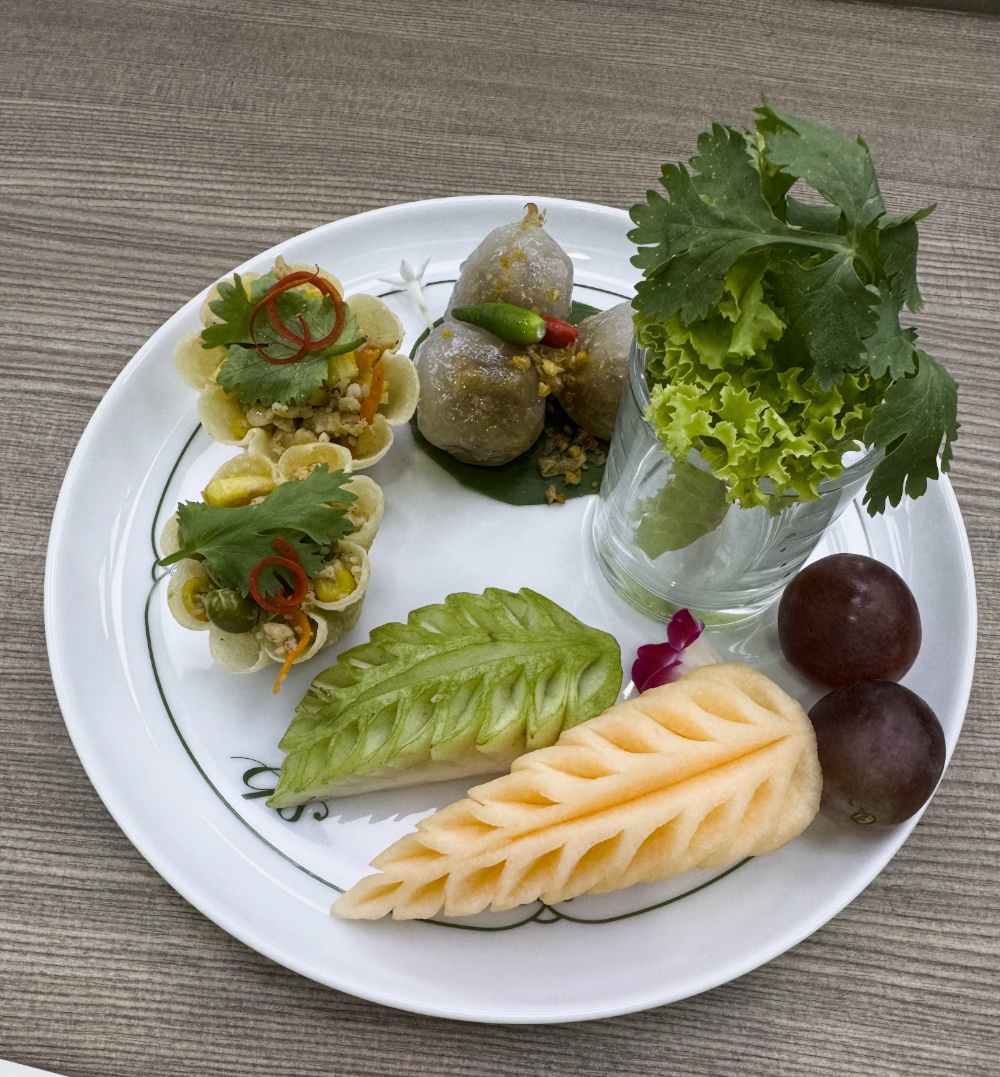 ของว่างระหว่างการฟังบรรยาย กระทงทอง ที่เราปรับมาเป็นของเราจาก Peranakan Hat ของว่างของชาวเปอรานากัน สาคูไส้หมู ที่มีเนื้อสัมผัสชวนให้นึกถึงไข่เหี้ย นอกจากนั้นการจัดจาน นอกจากความสวยงามแล้ว ยังต้องคำนึงถึงการเข้ากันของอาหาร วิธีการรับประทานแต่ดั้งเดิม และทุกอย่างบนจานต้องรับประทานได้
ของว่างระหว่างการฟังบรรยาย กระทงทอง ที่เราปรับมาเป็นของเราจาก Peranakan Hat ของว่างของชาวเปอรานากัน สาคูไส้หมู ที่มีเนื้อสัมผัสชวนให้นึกถึงไข่เหี้ย นอกจากนั้นการจัดจาน นอกจากความสวยงามแล้ว ยังต้องคำนึงถึงการเข้ากันของอาหาร วิธีการรับประทานแต่ดั้งเดิม และทุกอย่างบนจานต้องรับประทานได้
การได้มารับฟังการเสวนาครั้งนี้ ทำให้เห็นถึงความสำคัญที่สถานการศึกษาจะต้องมีครูอาจารย์ ที่เปี่ยมไปด้วยความรู้ ความเมตตา ความรู้ที่ลึกซึ้งแต่ก็เห็นภาพกว้างเพื่อสร้างวิสัยทัศน์ให้แก่การเรียนรู้เพื่อให้คนรุ่นใหม่สามารถเข้าใจ เห็นคุณค่าในของเก่า และสามารถนำไปต่อยอดได้อย่างไม่สั่นคลอน ก็เพราะเมื่อเรามีความหนักแน่นในความรู้พื้นฐาน ของดั้งเดิมของเราแล้ว เราก็จะสามารถสร้างของใหม่ เพิ่มความคิดสร้างสรรค์เข้าไปได้ แบบไม่ผิดเพี้ยน ใหม่ แต่ยังคงความเป็นไทย เพราะเราเข้าใจว่ารากเหง้าของเราคืออะไร ไม่ว่าเราจะแต่งตัวใหม่เป็นอะไรก็ตาม แต่เรายังคือคนไทยถึงกระดูกดำ
Attending this seminar made me realised the importance of educational institutions to have teachers who are not only knowledgeable but also compassionate. These educators must have both deep expertise and a broad perspective to create a vision for learning. This enables younger generations to understand and appreciate the value of the past, while confidently building upon it. When we are firmly rooted in our foundational knowledge and traditions, we can innovate and add creativity without losing our essence. Though we are accepting new things in all aspects of our life, we will be able to retains the core of our Thai identity. No matter how we evolve, we will remain real Thai to the bone.
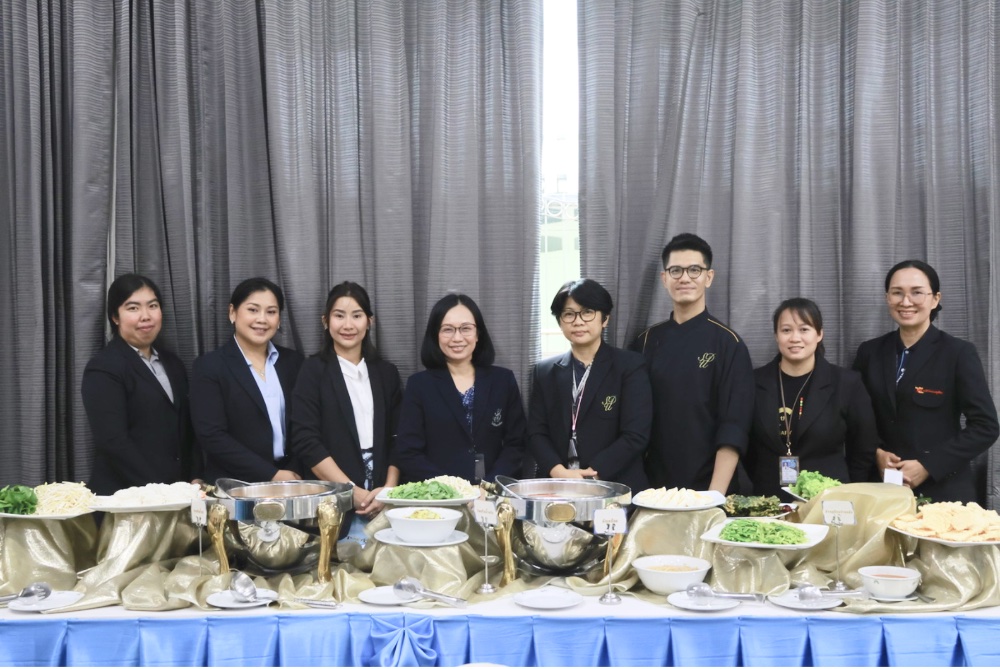 จากมหาวิทยาลัยสวนดุสิต จากซ้าย นางสาวลัดดา สังขฤกษ์ ดร.พรรณรพี เอี่ยมทวีเจริญ อ.กันต์กนิษฐ์ จงรัตนวิทย์ นางสาวรณิดา ศรีธนาวรุณ นางสาวจารุณี ชัยกิตติภูมิ อ.เป็นเอก ทรัพย์สิน นางสาวเจนจิตรา ภูผิวฟ้า นางสาวพรนภัส สุขารมย์
จากมหาวิทยาลัยสวนดุสิต จากซ้าย นางสาวลัดดา สังขฤกษ์ ดร.พรรณรพี เอี่ยมทวีเจริญ อ.กันต์กนิษฐ์ จงรัตนวิทย์ นางสาวรณิดา ศรีธนาวรุณ นางสาวจารุณี ชัยกิตติภูมิ อ.เป็นเอก ทรัพย์สิน นางสาวเจนจิตรา ภูผิวฟ้า นางสาวพรนภัส สุขารมย์
มหาวิทยาสวนดุสิต ได้ดำเนินการให้การศึกษามากว่า 90 ปีแล้ว โดยเมื่อก่อตั้งเป็น “โรงเรียนการเรือนพระนคร” เมื่อปีพ.ศ. 2477 ก็กลายเป็นโรงเรียนการเรือนแห่งแรกของไทย มีวิชาการสอนที่ทันสมัยมาก ๆ โดยเฉพาะเมื่อเรามองจากมุมมองยุคปัจจุบัน ที่สังคมกำลังหมุนกลับมาสู่สิ่งที่ง่ายและเป็นธรรมชาติที่สุด เช่น วิชาหลักการซักฟอกและหุงต้ม วิชาสุขวิทยา วิชาหลักการเลือกอาหาร วิชาการปรุงอาหาร วิชาวาดเขียนและหลักการจัดบ้าน วิชาสอนเบ็ดเตล็ดการเรือน และอื่น ๆ ที่ล้วนประกอบเป็นทักษะพื้นฐานในการมีชีวิตที่ดีทั้งนั้น โดยรายชื่อครู อาจารย์ ตั้งแต่ยุคก่อตั้ง จนถึงปัจจุบัน ก็คือเหตุผลว่าทำไม สวนดุสิต จึงสามารถรักษาชื่อเสียงของการเป็นสถานศึกษาด้านอาหารและโภชนาการได้มาจนถึงปัจจุบัน
Suan Dusit University has been providing education for over 90 years. When it was first established as “Phranakhon Culinary School” in 1934 (B.E. 2477), it became Thailand’s first home economics school. Its curriculum was highly advanced for its time, especially when viewed from today’s perspective, as society returns to simplicity and natural living. Among their founding courses were ‘The Principles of Laundry and Cooking,’ The Hygiene Lessons,’ How to Select Your Food and Ingredients,’ ‘The Thai Culinary Arts,’ ‘Drawing and Home decoration,’ as well as many more various household skills that formed the essential foundation for a good life. The list of teachers, from its founding to the present, explains why Suan Dusit has maintained its reputation as a leading institution in food and nutrition education to this day.
And this seminar “A Review of Suan Dusit Dishes,” held on 23 July 2024, shared insights from the research project “Suan Dusit’s Culinary Culture” that was conducted by the speakers themselves.
โดยการสัมนา “พินิจสำรับสวนดุสิต” ที่จัดขึ้นเมื่อวันที่ 23 กรกฏาคม 2567 ที่ผ่านมา เป็นการบอกเล่าเกร็ดความรู้ จาก งานวิจัยเรื่อง “วัฒนธรรมการบริโภคอาหารแบบฉบับสวนดุสิต” ในปีงบประมาณ 2567 โดยผศ.ดร.สาระ มีผลกิจ และ ผศ.ดร.ดวงกมล อัศวมาศ มหาวิทยาลัยสวนดุสิต โดยสำรับสวนดุสิตที่ได้ถูกกล่าวถึง มี 10 จาน ดังนี้
ของว่าง – เมี่ยงคำ กระทงทอง ข้าวตังหน้าตั้ง ข้าวเกรียบปากหม้อและสาคูไส้หมู
ของคาว – ขนมจีนน้ำยา ขนมจีนน้ำพริก ผัดไทย
ของหวาน – บัวลอยเผือก และเต้าส่วน
And here are the 10 signature dishes from Suan Dusit University:
Starters:
- Miang kham
- Kratong thong
- Khao tang na tang
- Khao krieb pak mor and saku sai moo
Main Courses:
- Khanom Chin nam ya
- Khanom Chin nam prik
- Pad Thai
Desserts:
- Bua loi with taro
- Tao suan
โดยอาหารทั้งหมด สามารถหาซื้อและชิมได้ที่ Home Bakery ของมหาวิทยาลัย และโรงแรมสวนดุสิต เพลส
“อยากจะขอฝากไว้ 3 คำ สำหรับการรับประทานอาหารให้มีความสุขเพื่อชีวิตที่ดี” ดร.จันทร์จนา นักวิทยาศาสตร์การอาหาร ผู้จัดการ Home Bakery ของมหาวิทยาลัยสวนดุสิต ที่มีทอฟฟี่เค้กแสนอร่อยเป็นตำนาน และอาหารอีกมากมายที่น่าชิมมากกล่าว “หนึ่ง ให้ซาบซึ้งใจกับอาหารและผู้คน สอง เปลี่ยนจากการไปเพื่อกิน ให้เป็น การไปเพื่อเจอ และสาม ให้มีสติในการกิน”
ซึ่งเมื่อมีสติแล้ว ทุกอย่างก็จะแจ่มชัด ทั้งเรื่องรสชาติอาหาร เรื่องราวของอาหาร และคุณประโยชน์ของอาหาร ที่ทั้งหมดทำให้เราเห็นคุณค่าของอาหารที่อยู่บนจาน ทำให้รับประทานได้อร่อยมากยิ่งขึ้น
All the dishes can be sampled at the university’s Home Bakery and Suan Dusit Place Hotel.
“I’d like to leave you with three tips for enjoying food for a better life,” said Dr. Chanchana, food scientist and manager of Suan Dusit University’s Home Bakery, known for its legendary toffee cake and other delectable treats. “First, appreciate the food and the people. Second, shift from eating just to eat, to eating to connect. Third, eat mindfully.”
“Because when we are mindful, everything becomes clearer—flavour, the story behind the food, and its benefits. This mindfulness enhances our appreciation and enjoyment of the food on our plate.”
สามารถชมการสัมนาทั้งหมดได้ที่นี่
You can watch the entire seminar here.
สามารถสั่งอาหารจาก Home Bakery ได้ที่นี่
Order from Home Bakery here.
โดยทาง Home Bakery สามารถบริการได้ทั้งแบบ delivery ปรกติ และ catering โดยหากมีบริการเป็น Food Truck จากสวนดุสิตด้วย น่ารักมากค่ะ
Both regular delivery and catering services are available, and there’s also a charming food truck service from Suan Dusit.
🍀🍀🍀
